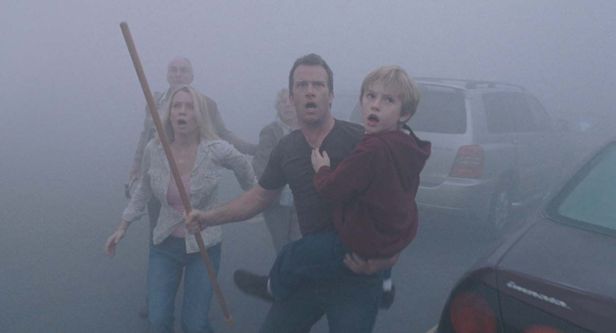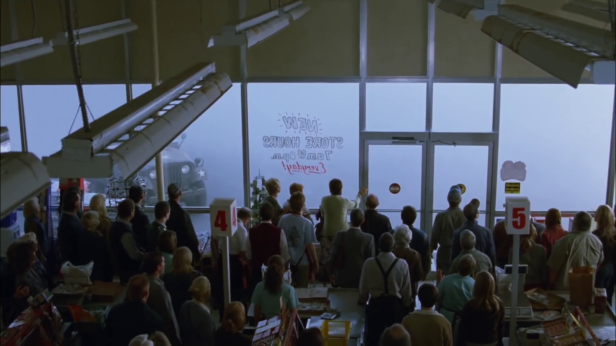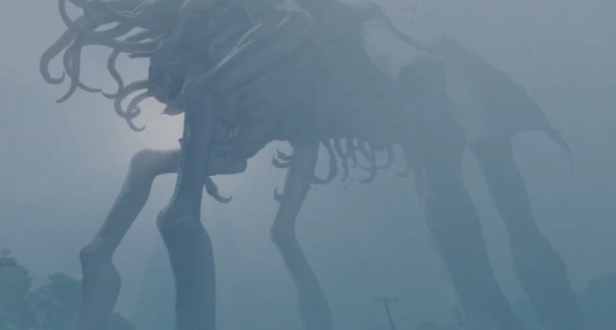Director/producer had form when it came to adapting the works of Stephen King but anyone expecting the same uplifting, feel good experience as The Shawshank Redemption (1994) and The Green Mile (1999) from his adaptation of King’s 1980 novella of the same name (first published in the anthology Dark Forces: New Stories of Suspense and Supernatural Horror and later collected, in edited form, in King’s own Skeleton Crew in 1985) will be in for a very nasty shock. Bleak, despairing and nihilistic, its take on the human condition is far less positive than Darabont’s previous King films and it ends in one of the most distressing climaxes for years.
A violent thunderstorm lashes the small Maine town of Castle Rock (a regular setting for King’s work), leaving the Drayton home seriously damaged. Film poster artist David Drayton (Thomas Jane) takes his young son (Nathan Gamble) shopping for supplies and is in a supermarket when a strange mist descends from the nearby mountains and envelops the town. A man (Jeffrey DeMunn) rushes in babbling about there being “something in the mist” as earth tremors rock the building. Trapped inside the building with the deeply religious but clearly insane Mrs Carmody (Marcia Gay Harden) and a large number of terrified and confused people, Drayton struggles to protect his son as the supermarket is besieged by a variety of monsters that are lurking in the mist, including huge flying insects, giant spiders, a huge mantis-like creature and something so huge it can barely be made out.

Though at 126 minutes it’s too long for its own good, The Mist is nonetheless a constantly surprising and gripping film in which Darabont seems determined to undermine the reputation he earned thanks to his previous King films. Every time you think someone’s going to display an act of heroism, or have a life-affirming interaction or enjoy a transformational revelation, Darabont pulls the rug from under you. Right from the start, when he refuses to help a terrified mother (Melissa McBride) to leave the supermarket so she can get home to her children to look after his own son, Drayton is far from a man prepared to do the right thing. Throughout, he’s no hero – he makes mistakes, accidentally causes people to die and leaves the viewer uncertain as to how much we really trust him. Even in the film’s gut punch of a climax he ends up doing what he thinks is the the right thing only to be left traumatised when he realises that a few more seconds of patience would have yielded very different and more positive results. As consequence, he’s a more identifiable hero than you’d find in many other horror films – fallible, desperate and frankly out of his depth, he’s no better than us, just an ordinary Joe struggling (and mostly failing) to comprehend the horrors unfolding around him.
Perhaps the only thing in The Mist that feels familiar and expected is the Old Testament ravings of the increasingly delusional Mrs Carmody. Harden is fine in the role, but it’s a character we’ve seen many times from King, from Carrie’s deranged mother to the demonic Randall Flagg in The Stand, from the well-meaning but inept minister turned faith healer in Revival to the children of Gatlin in Children of the Corn. But at least Darabont makes good use of a fairly stock character, using Camody as the catalyst for a rapid breakdown in the trapped group, Carmody gathering a group of terrified and increasingly dangerous acolytes around her who pose as much of a danger to Drayton and his more level-headed but seriously outnumbered allies (DeMunn, Laurie Holden, Frances Sternhagen, Buck Taylor) as the monsters outside. The polarisation of the two opposing groups had a considerable political bent to it in 2007 and seems even more horribly pertinent a decade or so later.

The monsters, all beautifully realised CGI creations designed by Gregory Nicotero, are used sparingly. The real horrors are inside the supermarket not outside but when they do appear they’re an impressive menagerie of Lovecraftian horrors. The big set-pieces – the supermarket being invaded by a swarm of insects whose bites are revoltingly toxic and who are pursued by the bat-like monstrosities that prey on them, the trip into the spider-infested pharmacy, the fleeing group of survivors close encounter with a skyscraper-sized creature – are all extremely well done but really The Mist is more about the way people are likely to react to such an outrageously unlikely set of circumstances as it is about the monsters themselves. The Shawshank Redemption and The Green Mile were paeans to the triumph of the human spirit over adversity, upbeat and emotional films about decency, kindness and hope. The Mist is an agonised howl of despair – apart from Laurie Holden’s school teacher, no-one on “our” side in the conflict thinks twice about abandoning the rest of the besieged townsfolk to their fate when they decide to flee the supermarket. And the mob mentality that grips the others, leading them to mortally wound a young soldier before throwing him out to be snatched away by one of the monsters after they learn that the creatures are likely to have come from another dimension through a portal opened by a scientific experiment he was attached to, is shocking not simply for how quickly it escalates but also because by then we were more or less expecting it. Where Shawshank and The Green Mile carry us along on a growing tide of hope for redemption, The Mist drowns us in the horrible realisation that in a crisis we’re all likely to turn into self-interested, terrified arseholes willing to grasp at any straw of comfort we can find, no matter how delusional it may be.
It all comes to a head in that ending, a devastating climax that leaves you with no hope, nothing good to cling on to as the credits start to roll. King’s original had ended with a tiny shred of hope, with the fate its group of survivors uncertain but with a single word heard through static on the radio, possibly a little brighter than the fate that befalls the same group here. King himself was impressed by the new, more downbeat ending though it alienated some of the audience who felt it was just too bleak, too unforgiving after all the horrors of the previous two hours. Even this late in the game, Darabont is prepared to wrong foot his audience – he sets us up for one last monster attack but suddenly the mist starts to clear and the real horror of what Drayton has just done hits both him and us at the same time. Instead of comforting us, the sight of familiar faces sitting in a passing truck just add to the sense of awful despair.

Darabont had originally wanted to film The Mist in black and white, inspired by George Romero’s similarly despairing Night of the Living Dead (1968) but selling the idea of a monochrome monster film to producers Dimension Films would have been a thankless task. He got a chance to present the film as he’d envisioned it on DVD when the colour version sat alongside his monochrome version. It may, at first sight, appear to have been a mere indulgence on Darabont’s part but in fact the black and white version is a very different experience – if anything it’s even bleaker and more unsettling than the colour version and should be the preferred viewing option.
Darabont went on to develop and executive produce the first season of AMC’s zombie apocalypse series The Walking Dead, taking three of his The Mist cast – Jeffrey DeMunn, Laurie Holden and Melissa McBride – with him. A television series of The Mist was produced by the cable channel Spike in 2017, without any input from Darabont, but it failed to make much of an impact and was cancelled after a single season.
My first introduction to The Mist was a 3D-audio cassette will William Sadler playing David Drayton. It was quite enjoyable and for me will always be the best version. That’s why I was negatively affected by the film, even though Marcia Gay Harden with her own talents had considerably improved on the villainous role of Mrs. Carmody. I’ve liked her ever since I first saw her in The Spitfire Grill. So I can always appreciate how proper acting can still in certain ways benefit an otherwise troubling film. Especially one that was a departure from what Frank Darabont was deservingly popular for thanks to The Shawshank Redemption and The Green Mile. For whatever reasons his own version of The Mist was made the way it was, it did have important things to say about the dark sides of the human condition, as do several horror films with similar premises. Thanks, Kevin, for your review.
LikeLiked by 2 people